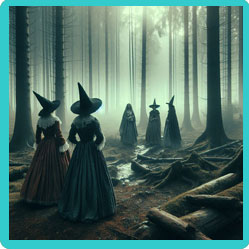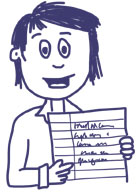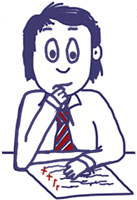
Witches in History
Witches have been a topic of fascination and fear throughout history. The concept of witches varies across cultures and time periods, but generally, they are believed to possess supernatural powers that enable them to harm others.
In Western culture, witches have often been associated with the devil and have been the target of persecution and witch hunts. These witch hunts reached their peak during the early modern period, particularly in Europe and North America, and resulted in the execution of thousands of people, mostly women, accused of practising witchcraft.
Today, the image of the witch has been reinterpreted in popular culture as a symbol of feminine power and independence. However, the history of witches remains a dark and complex subject that has shaped our understanding of gender, power, and belief.
Witches in Britain
The history of witches in Britain is a long and complex one, stretching back to the pre-Christian era. In ancient times, witches were believed to be wise women who possessed knowledge of herbal medicine and other natural remedies. However, with the rise of Christianity, the perception of witches changed. They began to be associated with the devil and were seen as evil and dangerous.
During the medieval period, witchcraft was considered a crime punishable by death, but it was not until the 16th and 17th centuries that the fear of witches reached its peak. In 1563, the Witchcraft Act was passed, making it a crime to practice witchcraft, and in 1604, King James I passed the Witchcraft Act of 1604, which made it a capital offence to summon spirits or practice witchcraft that caused harm to others.
The 17th century saw a surge in witch hunts across Britain, particularly in Scotland and England. One of the most infamous cases was the North Berwick witch trials, which took place in Scotland between 1590 and 1592. During these trials, over 100 people were accused of witchcraft and 70 were convicted and executed.
Revision Notes

The Cornell method is like a supercharged note-taking system that helps you ace your revision!
Print out our blank revision notes pages to help you revise.
How to make effective revision notes with the Cornell method.
Exam Questions & Answers

Download and print off practice our FREE worksheet with exam style questions on Cell Biology.
Witch hunts
During witch hunts thousands of people, mostly women, were accused of practicing witchcraft and were subjected to trial, torture, and execution.
The first witch hunt in Britain occurred in 1563 when Queen Elizabeth I passed the Witchcraft Act, which made it a crime to practice witchcraft or use magic to cause harm to others. This led to a surge in accusations of witchcraft, particularly against women, who were seen as the most likely to engage in such practices.
The witch hunts were driven by a fear of the supernatural and a belief in witchcraft as a source of evil. People who were accused of witchcraft were often subjected to torture in order to extract confessions, and many innocent people were executed based on flimsy or fabricated evidence.
The witch hunts began to decline in the 18th century, as people began to question the validity of accusations of witchcraft and the use of torture to extract confessions. In 1735, the Witchcraft Act of 1604 was repealed, and witchcraft was no longer considered a capital offence.

Pendle witch trials
The Pendle witch trials were a series of trials that took place in Lancashire, England, in 1612. The trials were held at Lancaster Castle and were presided over by judges who were determined to root out witchcraft in the region.
During these trials, 12 people were accused of practising witchcraft, and 10 were executed. The trials were sparked by an incident involving a young girl named Alison Device, who was accused of witchcraft after she was seen begging for food from a peddler. She claimed that her grandmother, Elizabeth Southerns, known as "Old Demdike," was a witch and that she and her family had been using magic to harm others.
The authorities arrested Demdike, as well as her daughter, granddaughter, and several other people who were believed to be involved in witchcraft. The accused were subjected to harsh interrogation, and several of them, including Demdike, died in prison before they could stand trial.
The trials themselves were a farce, with little evidence presented against the accused except for rumours and hearsay. Nevertheless, ten people were convicted of witchcraft and sentenced to death. They were hanged at Gallows Hill in Lancaster on August 20, 1612.
North Berwick witch trails
The North Berwick witch trials were a series of trials that took place in Scotland between 1590 and 1592, during the reign of King James VI of Scotland (who later became King James I of England). The trials were held in the town of North Berwick and were presided over by the Scottish courts.
The trials were sparked by accusations that a group of witches had conspired to assassinate King James VI by casting spells and using black magic. The authorities arrested dozens of people, mostly women, who were suspected of being involved in witchcraft.
The accused were subjected to harsh interrogation and torture, and many of them were forced to confess to crimes they had not committed. Some of the most notorious confessions involved stories of witches holding meetings with the devil, flying on broomsticks, and casting spells on their enemies.
Over 100 people were accused of witchcraft during the North Berwick trials, and over 70 were convicted and executed. The trials were marked by gross injustices and abuses of power, with the accused being denied legal counsel and subjected to torture in order to extract confessions.
Salem witch trails
The Salem witch trials were a series of hearings and prosecutions of people accused of witchcraft in colonial Massachusetts between February 1692 and May 1693. Over 200 people were accused of witchcraft, with 20 of them being executed.
The trials began when a group of young girls in Salem Village (now Danvers, Massachusetts) claimed to be possessed by the devil and accused several local women of witchcraft. The accused were brought before the court and forced to defend themselves against the charges, often facing harsh questioning and pressure to confess.
The trials were marked by a lack of due process and the use of spectral evidence, which was based on the girls' testimony of seeing the accused in their dreams or visions. Many of those accused were convicted and sentenced to death, while others were imprisoned for months or years.
The trials eventually came to an end when the governor of Massachusetts intervened and put an end to the proceedings. The colony later admitted that the trials were a grave miscarriage of justice, and many of those accused and convicted were exonerated posthumously.
The Salem witch trials remain a dark chapter in American history and continue to be studied and debated today as an example of the dangers of mass hysteria, the abuse of power, and the importance of protecting the rights of the accused.
Famous witches
There have been many witches throughout history who have gained notoriety for their supposed powers and practices. Here are some of the most famous witches in history:
- The Witch of Endor - Mentioned in the Bible, the Witch of Endor is said to have summoned the spirit of the prophet Samuel at the request of King Saul.
- Morgan Le Fay - A powerful sorceress in Arthurian legend, Morgan Le Fay was said to have magical powers and was often depicted as a villain.
- Baba Yaga - A witch from Slavic folklore, Baba Yaga is known for her iron teeth, wild hair, and ability to fly through the air in a mortar and wield a pestle as a weapon.
- Mother Shipton - A legendary witch from England who lived in the 16th century, Mother Shipton was said to have prophetic powers and was known for her disturbing predictions.
- Tituba - A slave from Barbados who was accused of witchcraft during the Salem witch trials, Tituba was said to have used her supposed powers to control and manipulate young girls in the community.
- Marie Laveau - A practitioner of voodoo in New Orleans in the 19th century, Marie Laveau was said to have had powerful magical abilities and was revered as a spiritual leader in her community.
- Aleister Crowley - Although he was not a witch in the traditional sense, Aleister Crowley was a controversial figure in the early 20th century who practised a form of occultism and was known as "the wickedest man in the world."
These are just a few examples of the many witches who have captured the imagination of people throughout history. Whether real or legendary, witches have played an important role in shaping our understanding of the supernatural and the power of magic.
10 Facts about witches

- The term "witch" comes from the Old English word "wicce," which means "wise woman." In the past, witches were often seen as healers and wise women who possessed knowledge of herbs and natural remedies.
- Many cultures throughout history have believed in the existence of witches and witchcraft. For example, ancient Greeks believed in the practice of "goetia," a form of magic that involved invoking spirits to achieve desired outcomes.
- The image of witches riding on broomsticks likely comes from medieval folklore, which held that witches would apply a magical ointment to a broomstick and use it to fly to their meetings with the devil.
- During the Salem witch trials, animals were also accused of witchcraft. Dogs were believed to be possessed by the spirit of a witch. As a result of the trials, two dogs were killed.
- In medieval Europe, it was believed that witches could use their magical powers to cause impotence in men. As a result, many men were fearful of witches and accused them of casting spells on them.
- Some cultures believed that witches could transform themselves into animals, such as cats or birds. This belief likely contributed to the association between witches and black cats that persists to this day.
- In some cultures, it was believed that witches could control the weather. This led to accusations of witchcraft during times of drought or flooding, as people believed that the witches had caused the natural disasters.
- Some accused witches were forced to undergo "witch tests," which involved being bound and thrown into a body of water. If the accused witch floated, it was believed that they were in league with the devil and guilty of witchcraft, and would be sentenced to death. If they drowned then they weren't a witch. Either way, it's not a good outcome.
- The persecution of witches led to some bizarre and extreme methods of punishment. For example, in Germany, some accused witches were made to wear a spiked collar or other instruments of torture, while others were burned alive at the stake.
- In some cultures, such as those in Africa and South America, witchcraft is still practised today as a form of traditional medicine and spirituality.
Witch hunters
Witch hunters were individuals or groups who were responsible for identifying, accusing, and prosecuting people suspected of practising witchcraft. In many cases, witch hunters were motivated by religious or political beliefs, and their activities often resulted in the persecution and execution of innocent people.
During the witch hunts of the 16th and 17th centuries in Europe, many witch hunters were officials of the Catholic Church or local authorities who were tasked with enforcing laws against witchcraft. They were often aided by self-proclaimed witch-finders, who claimed to have the ability to identify witches through various methods, such as examining the accused for "witches' marks" or using trial by ordeal.
Matthew Hopkins
Matthew Hopkins was an English witch-hunter who is believed to have been responsible for the execution of hundreds of people during the 17th century. Hopkins was born in Wenham Magna, Essex, in 1620, and is thought to have started his witch-hunting career in the 1640s.
Hopkins became famous for his role in the trials and executions of suspected witches in East Anglia, particularly in Essex and Suffolk. He claimed to be a self-appointed "Witchfinder General," and travelled throughout the region, charging fees for his services and using controversial methods to identify witches.
Hopkins' methods included searching the accused for "witches' marks," such as moles or scars, which were believed to be the Devil's mark. He would also conduct "pricking" tests, in which he would use a needle to probe the accused's skin, supposedly to find a spot that did not bleed, indicating that the person was a witch.
Hopkins was known for his harsh treatment of the accused, and he was accused of using torture and sleep deprivation to extract confessions. His methods were controversial even at the time, and he was criticized by some members of the clergy for his lack of evidence-based investigations.
It is estimated that Hopkins was responsible for the execution of over 300 people during the witch trials, making him one of the most notorious witch-hunters in English history. However, his methods and the validity of his accusations have been widely questioned in the centuries since his death.
Witch punishment
Witches were punished in a variety of ways throughout history, depending on the time and place of the accusation. The punishment varied from minor fines and imprisonment to brutal torture and execution. Some of the most common punishments for witches were:

- Imprisonment: Suspected witches were often imprisoned for long periods without trial or due process. They were often subjected to inhumane conditions and sometimes died in jail.
- Fines: In some cases, witches were punished with fines or other monetary penalties, which could be significant.
- Public humiliation: In some cases, witches were subjected to public humiliation, such as being paraded through the streets in shackles or forced to wear a sign or symbol of their supposed crime.
- Torture: Torture was commonly used to extract confessions from accused witches. The methods used varied but often included the use of thumbscrews, the rack, or waterboarding.
- Execution: Execution was the most severe punishment for witches, and often took the form of hanging or burning at the stake. In some cases, witches were also drowned or stoned to death.
The last witch execution
The last witch execution in the UK was in 1727, when an elderly woman named Janet Horne was accused of witchcraft in Dornoch, Scotland. Horne and her daughter were accused of practicing witchcraft, and were subjected to torture in an attempt to extract a confession.
After a confession was obtained, Horne was sentenced to be burned at the stake. However, her daughter was able to escape and was never seen again.
The case of Janet Horne is considered to be the last execution for witchcraft in the UK. While belief in witchcraft persisted in some communities for several more years, the practice of prosecuting and executing suspected witches gradually declined throughout the 18th century, as attitudes towards witchcraft and superstition began to change.
Revision Notes

The Cornell method is like a supercharged note-taking system that helps you ace your revision!
Print out our blank revision notes pages to help you revise.
How to make effective revision notes with the Cornell method.
Why Do I Need to Know About Witches?
In Everyday Life
- Understand how fear, rumours, and blame shape society
- Spot how people treat outsiders — then and now
- Think critically about beliefs, power, and fairness
In History & Related Careers
- Learn how governments use fear to control people
- Build strong skills in analysing sources and arguments
- Explore big themes like justice, persecution, and change


